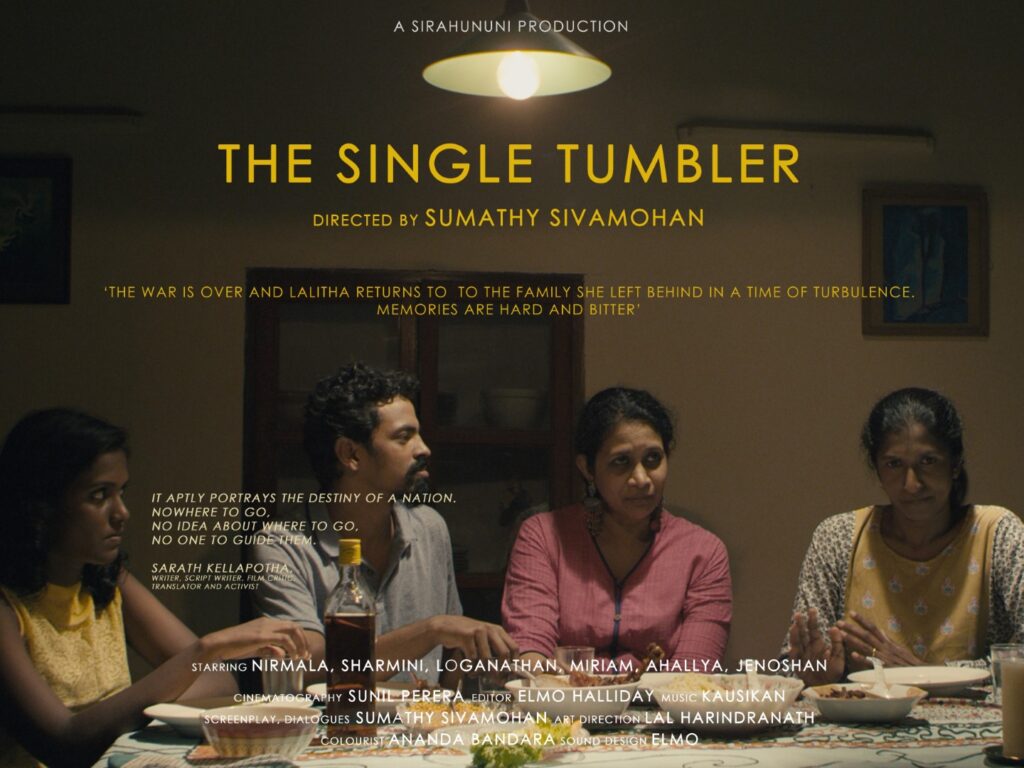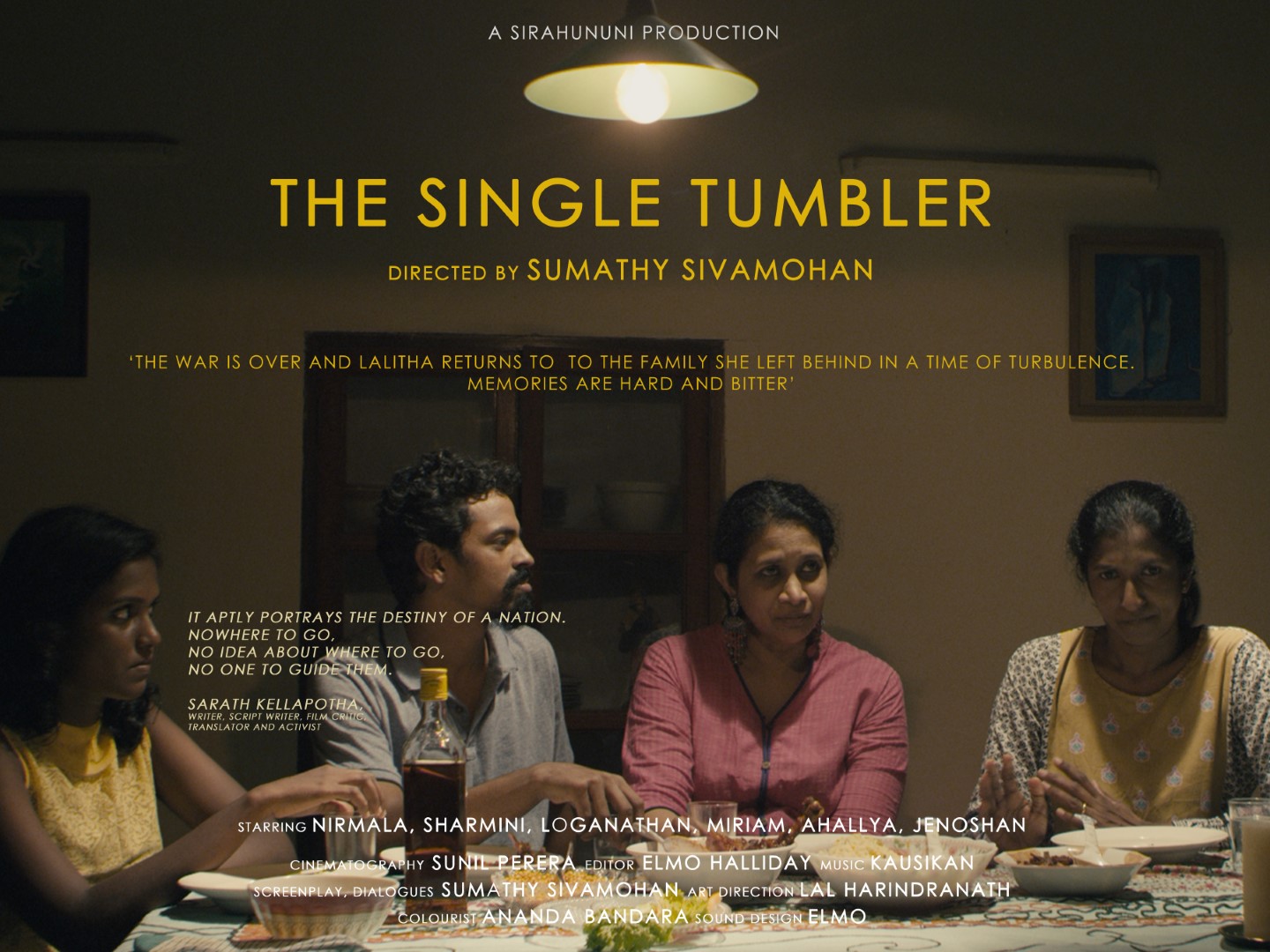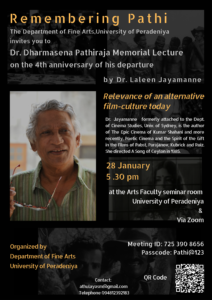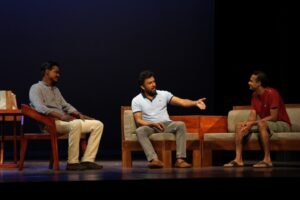
Sumathy Sivamohan’s latest feature film “The Single Tumbler”, woven around stories of a single family, is a heart-wrenching tale of life, war, loss, trauma, and the search for answers. The film centres on the loss or disappearance of Jude, a brother and son, during the war in Sri Lanka, foregrounding the eviction of Muslims from the North in 1990. Daisy Teacher, Jude’s mother not only lost a son; she also lost her friend Fathima Teacher to the war. Fathima Teacher’s promise of returning in a few days or at most, two weeks, tugs at the heart strings of viewers familiar with the stories of Sri Lanka’s war. The expensive, good quality set of brass tumblers that Fathima Teacher handed over to Daisy Teacher before she was forced to leave her home is a symbol of their bond; but the tumblers are destroyed by events beyond their control, with just a single lonely tumbler barely surviving it all. The insurmountable pain of these two characters converges in the single tumbler, isolated, burnt, and warped beyond repair or redemption, a microcosm of the sufferings of their respective communities.
Lalitha, Jude’s sister who has returned from Canada, seeks an end to the mystery surrounding Jude’s disappearance. Yet for Daisy Teacher and Lalitha’s two siblings Jessie and Anthony, it is a chapter they are struggling to forget or put behind them. Lalitha’s numerous attempts at finding out the truth are met with bitterness, regret, and reproach. Her own life has been a difficult one, as a migrant refugee, signalling a whole other world of struggle brought about by the war. In response to Lalitha’s insistent questions about why the family didn’t let her know about what was going on back in Sri Lanka, Jessie says “even a single piece of paper could be dangerous”. I acutely felt the power of this line, for it reminded me of the volatile and anxious times right after the 2019 Easter Sunday bombings. Too many lives have been terrorised due to sheer misunderstanding or the lack of any effort to understand.
This is not the first movie made about the war in Sri Lanka. This won’t be the last. But what stands out in this film is Sivamohan’s powerful story-telling through everyday dialogues, conversations, memories, and the old photo frames that hang in the background. The past incessantly stares at you from the walls, most poignantly invoked by the question: “Is this a home anymore?” Without bringing to screen any direct scenes from war, Sivamohan brilliantly brings to life its acute trauma and long-lasting impact. Her depiction of the tales and memories of the characters, while personal, are also undeniably political. A single family captures the lasting aftershocks of the war.
While the film is a solemn one, there is also an underlying note, urging one to “move on.” In one of the scenes, the siblings discuss the eviction and how Muslims are returning to their ancestral lands, when Daisy Teacher poignantly remarks: “New things, old tales.” There is a play on the old and the new. But the new, despite the old tales, are an indication of motion – positive or otherwise.
In another scene, Anu, Jessie’s daughter, the youngest character in the film, plays around a column that holds the old house upright while Daisy Teacher walks out with the tumbler. Anu asks her grandmother where she is going, and Daisy Teacher responds, “I am going to return this tumbler to Fathima Teacher.” Anu stops her playing and stares after her. This scene felt momentous. I wonder if it indicates that Daisy Teacher is finally trying to move on; for a long time she had tried to destroy the tumbler, consciously or unconsciously, and through it the connection to Fathima Teacher. Although Anu is present throughout the whole film, she is never directly involved in any conversation in relation to the war. She seems to be in a blissful state of unawareness of the trauma that others feel. But now, Daisy Teacher possibly hands down the search, desire, yearning for reconciliation to the new generation, by declaring to Anu directly for the first time in the whole film that she is taking action, just like Jude who tried to stop the LTTE’s eviction of Muslims, before his disappearance.
There is an interesting portrayal of donkeys which appears several times in the film as almost coincidental appearances. First, in a scene where Lalitha is returning home from grocery shopping, they frolic across the road, almost running into the three-wheeler she is travelling in; a nuisance on the road. Then, during a hallucination or dream scene, where she walks out into the night, trailing behind her missing brother, hopeful of reaching him and speaking to him finally, she also walks into a herd of donkeys; they are everywhere around her. She is walking among them and is almost hindered by them. In a response to my query about the donkeys in the film, Sivamohan stated that the donkeys represent displacement and a moment of fantasy that assists the process of truth making
Daisy Teacher, Fathima Teacher, and Lalitha are all walking with questions, seeking answers in this film. The rest of the characters, like the waves of the ocean, overlapping one after the other, spill on to the screen their personal tales and their woes, while weaving the larger picture of the war and all the politics surrounding it into a tapestry of narratives and counter narratives. The answer, like the corpse washed ashore in the end is perhaps death, the death of laughter, death of dreams, death of families, and death of social ties. But woven through the film, especially in Lalitha Teacher’s journey in search of her friend to return the single tumbler to her, is also a subtle glimpse of a yearning for reconciliation.
Afrah Niwas holds a BA in English from the University of Peradeniya and is a writer, translator, and a social and environmental enthusiast.




